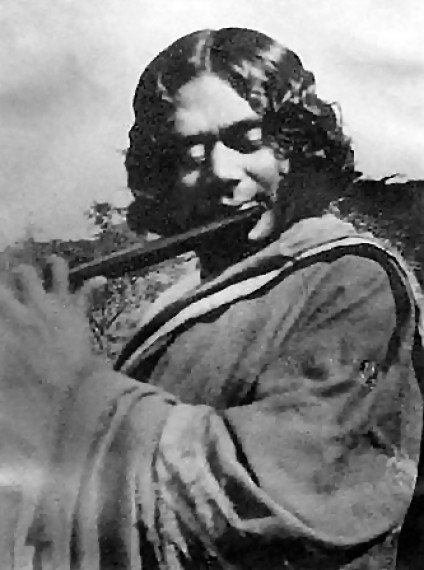
Kazi Najhrul Islam(part-2)

Nazrul joined the army at the end of 1917 AD. First to Fort William in Calcutta and later to Nowshera in Frontier Province for training. After training, he started living the life of a soldier in the Karachi cantonment. He was in the army from late 1917 AD to March-April 1920 AD, i.e. about two and a half years. During this period he rose from a common soldier corporal to a quartermaster habildar in the 49th Bengal Regiment. He learned Persian from the Punjabi Maulbi of the said regiment. Apart from this, he continued to practice music along with his fellow soldiers by playing different local and foreign musical instruments, and the practice of prose and poetry also continued at the same time. The works Nazrul completed while in Karachi Cantonment include Boundul's Autobiography (first prose work), Mukti (first published poem); Stories: Henna, Donation of Pain, Meher Negar, Sleepy Ghore, Kavita Samadhi etc. Despite being in this Karachi cantonment, he was a subscriber to various literary magazines in Calcutta. These include Pravasi, Bharat Varsha, Bharati, Mansi, Marmambani, Sabujpatra, Saugat and Bengali Muslim Literary Magazine. During this time he had some books by Rabindranath Tagore, Saratchandra Chatterjee and Persian poet Hafiz. According to this source, it can be said that Nazrul's literary practice took place in this Karachi cantonment. While still a soldier, he took part in the First World War. At that time, Nazrul's forces were supposed to go to Iraq. But as the war stopped, he did not go. When the war ended in 1920, the 49th Bengal Regiment was disbanded. [6] After that he left the military life and returned to CalcuttaAfter the war, Nazrul came to Calcutta and started living in the office of the Bengali Muslim Literary Society at 32 College Street. Muzaffar Ahmad, one of the officers of this association, lived with him. From here the main works of his literary-journalistic life began. Early on, some of his writings were published in Muslim Bharat, Bengali Muslim Literary magazine, Upasana etc. These include the novel Bandhan Hara and the poems Bodhan, Shat-il-Arab, Badal Prater Sharab, Aghani, Kheya-Par Tarani, Qorbani, Muharram, Fateha-e-Dawazdam, these works are particularly appreciated in the literary field. Following this, the poet and critic Mohitlal Majumdar wrote a critical article in Muslim Bharat magazine praising both his poems Kheya-par's Tarani and Badal Prat's Sharab Kavita. From this, Nazrul's close acquaintance with prominent writers and critics of the country began. Kazi Motahar Hossain, Mozammel Haque, Kazi Abdul Odud, Muhammad Shahidullah, Afzalul Haque etc. were introduced in the office of Bengali Muslim Literary Society. Atulprasad Sen, Abanindranath Tagore, Satyendranath Dutta, Premankur Atarthi, Shishirkumar Bhaduri, Saratchandra Chattopadhyay, Nirmelundu Lahiri, Dhurjatiprasad Mukhopadhyay, Hemikumar Roy became known by participating in Gajendar Adda and Bharatiya Adda, two popular literary gatherings of CalcuttaWith Dinendranath Tagore, Charuchandra Bandyopadhyay, Ustad Karamtulla Khan and others.In October 1921, he went to Shantiniketan and met Rabindranath. From then till the death of Rabindranath they maintained good relations. Nazrul developed a special friendship with Kazi Motahar HossainOn 12th July, 1920, an evening daily called Navayug began to be published. Published in the context of the Non-cooperation and Khilafat movement, the editor of this magazine was Shere-Bangla A.K. Nazrul started regular journalism through this newspaper Fazlul Haque. In the same year, he wrote an article titled "Who is responsible for killing Muhajireen" in this newspaper, for which the newspaper's deposit was confiscated and Nazrul was placed under police surveillance. However, through journalism, he got an opportunity to witness the political and social conditions of that time. At the same time Muzaffar got the opportunity to gain direct experience in politics by joining various political meetings and associations with Ahmad. Poetry and music were practiced together through various small programs. Even then he did not start writing songs himself. However, Brahmo Samaj's musicologist Mohini Sengupta was setting some of his poems to music and publishing them in newspapers with notation. These include: Maybe Tomar Paab Doha, Ore E Koon Sneh-Surdhuni- Her first song was published in the Baishakh issue of 1327 Bangald of Sawagat Patrika. The song was: "Bajao Prabhu Bajao Ghan"
